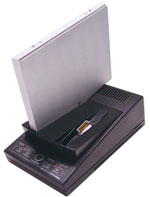Battery chargers vs. in-PowerBook charging


While it's true that Lithium-Ion batteries aren't susceptible to the "memory effect" of previous battery technologies (like NiMH, for example) a PowerBook battery only has a limited amount of charge cycles in its useful life. If you're constantly partial charging your 'Book, each of these counts toward your total cap of charges before the performance of your battery begins to drop off.
Apple has finally begun to acknowledge this fact on their dedicated batteries and notebook batteries pages, undoubtedly after some pressure from the iPod battery lawsuits. In a tiny sidebar called "Battery Lifespan" on the bottom right of their notebook batteries page they offer:
A properly maintained PowerBook or iBook battery is designed to retain up to 80% of its original capacity after 300 full charge and discharge cycles. You may choose to replace your battery when it no longer holds sufficient charge to meet your needs.
So if you un-plug and re-plug your PowerBook every day, say to take it back forth to work or school, you should have 80% of its original capacity after less than a year. And that's if you believe Apple's marketing spin on batteries—and we know how accurate they are on that topic.
I avoid this unnecessary battery abuse by running my PowerBook battery down to empty as often as possible and when a battery dies I charge it in my groovy external battery charger from NewerTech. The NuPower Battery Charger/Condition retails for US$149 and is worth every penny. It allows me to charge or condition two batteries at once quickly and correctly and its "deep conditioning" feature extends the life of my batteries.
If your old PowerBook battery isn't lasting more than two hours, you should first check it with a freeware application like Branden Keller's excellent Capacity Meter and if its capacity is less than 50% invest in a new high-capacity Lithium-Ion replacement battery from NuPower. You won't regret it.